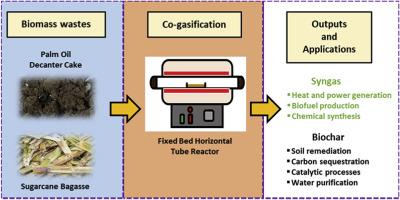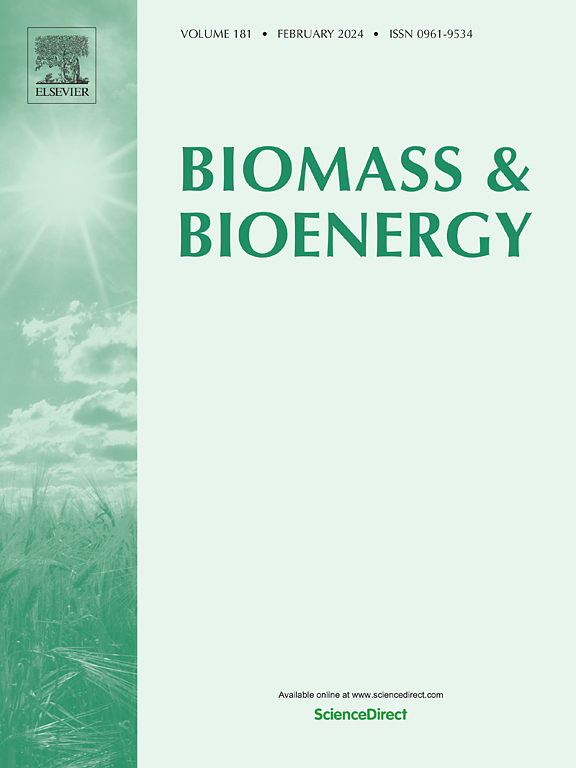RSM-based co-gasification of palm oil decanter cake and sugarcane bagasse: Syngas production and biochar characteristics
IF 5.8
2区 生物学
Q1 AGRICULTURAL ENGINEERING
引用次数: 0
Abstract
The production of syngas (CO + H2) and biochar from biomass waste co-gasification promotes sustainable energy while addressing environmental remediation challenges. This study investigates the co-gasification of palm oil decanter cake (PODC) and sugarcane bagasse (SB) to optimize syngas production and obtain biochar in a fixed bed horizontal tube furnace reactor. Operating variables, including temperature (700–900 °C), biomass ratio (30–70 wt%), and particle size (0.25–2 mm), were optimized using Response Surface Methodology with the Box-Behnken design. Characterization analyses including Brunauer-Emmett-Teller (BET), Fourier Transformed Infrared (FTIR), and Field Emission Scanning Electron Microscopic (FESEM) analyses were conducted on the biochar. The optimal conditions yielded a syngas volume of 41.5 vol% and a biochar of 0.3 wt%, achieved at 900 °C temperature, 42 wt% PODC biomass ratio, and 2 mm particle size. BET analysis revealed a mesoporous structure biochar with surface area of 398.55 m2/g, pore volume of 0.13 cm3/g, and pore diameter of 6.49 nm. FTIR analysis indicated the presence of hydroxyl groups, carbonyl groups, aromatic compounds, and hydrocarbon structures. FESEM analysis showed well-defined pore structures on the biochar surface, with EDX analysis confirming a dominant carbon content of 83.32 wt%. These findings substantially enhance sustainable approaches in energy production, agriculture, and wastewater treatment, while effectively tackling environmental issues associated with biomass waste.

基于 RSM 的棕榈油滗析饼和甘蔗渣联合气化:合成气产量和生物炭特性
从生物质废物联合气化中生产合成气(CO + H2)和生物炭可促进可持续能源的发展,同时应对环境整治方面的挑战。本研究调查了棕榈油滗析器滤饼(PODC)和甘蔗渣(SB)在固定床水平管式炉反应器中的联合气化,以优化合成气生产并获得生物炭。采用箱-贝肯(Box-Behnken)设计的响应面方法对温度(700-900 °C)、生物质比率(30-70 wt%)和粒度(0.25-2 mm)等操作变量进行了优化。对生物炭进行了特性分析,包括布鲁瑙尔-艾美特-泰勒(BET)、傅立叶变换红外(FTIR)和场发射扫描电子显微镜(FESEM)分析。在最佳条件下,合成气体积为 41.5 Vol%,生物炭为 0.3 wt%,温度为 900 °C,PODC 生物质比率为 42 wt%,粒径为 2 mm。BET 分析显示,生物炭为介孔结构,表面积为 398.55 m2/g,孔体积为 0.13 cm3/g,孔直径为 6.49 nm。傅立叶变换红外分析表明存在羟基、羰基、芳香族化合物和碳氢化合物结构。FESEM 分析表明,生物炭表面的孔隙结构非常清晰,EDX 分析证实其主要碳含量为 83.32 wt%。这些发现极大地促进了能源生产、农业和废水处理的可持续发展,同时有效地解决了与生物质废物相关的环境问题。
本文章由计算机程序翻译,如有差异,请以英文原文为准。
求助全文
约1分钟内获得全文
求助全文
来源期刊

Biomass & Bioenergy
工程技术-能源与燃料
CiteScore
11.50
自引率
3.30%
发文量
258
审稿时长
60 days
期刊介绍:
Biomass & Bioenergy is an international journal publishing original research papers and short communications, review articles and case studies on biological resources, chemical and biological processes, and biomass products for new renewable sources of energy and materials.
The scope of the journal extends to the environmental, management and economic aspects of biomass and bioenergy.
Key areas covered by the journal:
• Biomass: sources, energy crop production processes, genetic improvements, composition. Please note that research on these biomass subjects must be linked directly to bioenergy generation.
• Biological Residues: residues/rests from agricultural production, forestry and plantations (palm, sugar etc), processing industries, and municipal sources (MSW). Papers on the use of biomass residues through innovative processes/technological novelty and/or consideration of feedstock/system sustainability (or unsustainability) are welcomed. However waste treatment processes and pollution control or mitigation which are only tangentially related to bioenergy are not in the scope of the journal, as they are more suited to publications in the environmental arena. Papers that describe conventional waste streams (ie well described in existing literature) that do not empirically address ''new'' added value from the process are not suitable for submission to the journal.
• Bioenergy Processes: fermentations, thermochemical conversions, liquid and gaseous fuels, and petrochemical substitutes
• Bioenergy Utilization: direct combustion, gasification, electricity production, chemical processes, and by-product remediation
• Biomass and the Environment: carbon cycle, the net energy efficiency of bioenergy systems, assessment of sustainability, and biodiversity issues.
 求助内容:
求助内容: 应助结果提醒方式:
应助结果提醒方式:


